



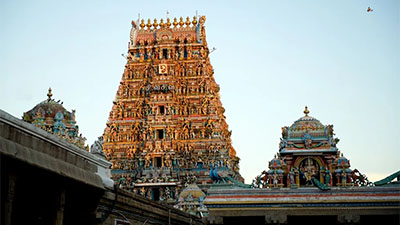 Sri Kapaleeshwarar Temple is a Hindu Temple dedicated to Lord Shiva located in Mylapore, Chennai. The form of Shiva's consort Parvati worshipped at this temple is called Karpagambal is from Tamil (Goddess of the Wish-Yielding Tree). The Temple is the most ancient one that has been built around the 7th century CE in Dravidian architecture.
Sri Kapaleeshwarar Temple is a Hindu Temple dedicated to Lord Shiva located in Mylapore, Chennai. The form of Shiva's consort Parvati worshipped at this temple is called Karpagambal is from Tamil (Goddess of the Wish-Yielding Tree). The Temple is the most ancient one that has been built around the 7th century CE in Dravidian architecture.
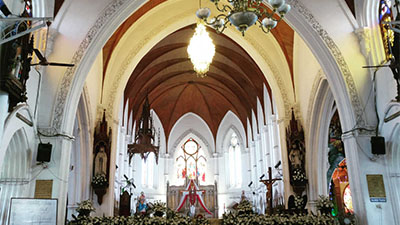 Santhome Church, also known as St. Thomas Cathedral Basilica and National Shrine of Saint Thomas is a Roman Catholic minor basilica in Santhome, in the city of Chennai (Madras). It was built in the 16th century by Portugueseexplorers, over the tomb of Saint Thomas, one of the twelve apostles of Jesus. In 1893, it was rebuilt as a church with the status of a cathedral by the British. The British version still stands today. It was designed in Neo-Gothic style, favoured by British architects in the late 19th century. This church is one of the only three known churches in the world built over the tomb of an apostle of Jesus, the other two being St. Peter's Basilica in Vatican City and Santiago de Compostela Cathedralin Galicia, Spain.
Santhome Church, also known as St. Thomas Cathedral Basilica and National Shrine of Saint Thomas is a Roman Catholic minor basilica in Santhome, in the city of Chennai (Madras). It was built in the 16th century by Portugueseexplorers, over the tomb of Saint Thomas, one of the twelve apostles of Jesus. In 1893, it was rebuilt as a church with the status of a cathedral by the British. The British version still stands today. It was designed in Neo-Gothic style, favoured by British architects in the late 19th century. This church is one of the only three known churches in the world built over the tomb of an apostle of Jesus, the other two being St. Peter's Basilica in Vatican City and Santiago de Compostela Cathedralin Galicia, Spain.
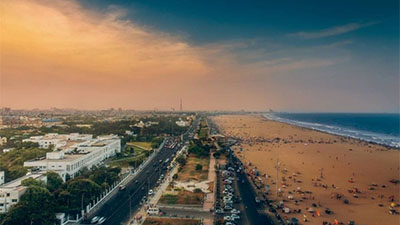 Marina Beach is a natural urban beach in Chennai, Tamil Nadu, India, along the Bay of Bengal. The beach runs from near Fort St. George in the north to Foreshore Estate in the south, a distance of 6.0 km (3.7 mi), making it the longest natural urban beach in the country.The Marina is primarily sandy, unlike the short, rocky formations that make up the Juhu Beach in Mumbai. The average width of the beach is 300 m (980 ft) and the width at the widest stretch is 437 m (1,434 ft).
Marina Beach is a natural urban beach in Chennai, Tamil Nadu, India, along the Bay of Bengal. The beach runs from near Fort St. George in the north to Foreshore Estate in the south, a distance of 6.0 km (3.7 mi), making it the longest natural urban beach in the country.The Marina is primarily sandy, unlike the short, rocky formations that make up the Juhu Beach in Mumbai. The average width of the beach is 300 m (980 ft) and the width at the widest stretch is 437 m (1,434 ft).
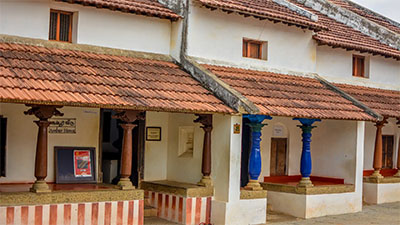 Dakshina Chitra (a picture of the south) is a living-history museum in the Indian state of Tamil Nadu, dedicated to South Indian heritage and culture. It is located 25 kilometres (16 mi) to the south of Chennai.
Dakshina Chitra (a picture of the south) is a living-history museum in the Indian state of Tamil Nadu, dedicated to South Indian heritage and culture. It is located 25 kilometres (16 mi) to the south of Chennai.
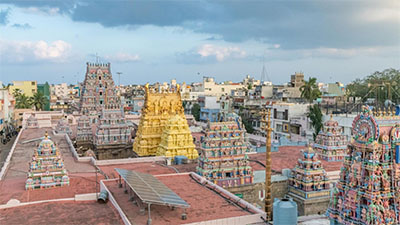 Sri Parthasarathy Temple is a 6th-century Hindu Vaishnavite temple dedicated to Lord Vishnu. The temple is glorified in the Naalayira Divya Prabandham, the early medieval Tamil literature canon of the Alvar saints from the 6th to 9th centuries CE and is classified as among the 108 Divya Desams.
Sri Parthasarathy Temple is a 6th-century Hindu Vaishnavite temple dedicated to Lord Vishnu. The temple is glorified in the Naalayira Divya Prabandham, the early medieval Tamil literature canon of the Alvar saints from the 6th to 9th centuries CE and is classified as among the 108 Divya Desams.
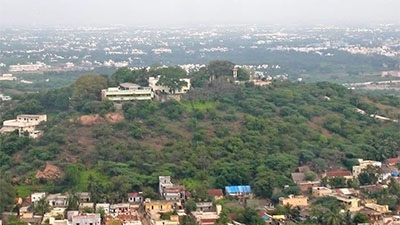 Parangimalai (St. Thomas Mount) is a small hillock near the neighbourhood of Guindy and very close to Chennai International Airport. By extension, it is also the name of the neighbourhood surrounding the hillock.
Parangimalai (St. Thomas Mount) is a small hillock near the neighbourhood of Guindy and very close to Chennai International Airport. By extension, it is also the name of the neighbourhood surrounding the hillock.
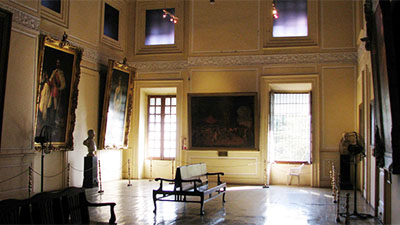 Fort St. George (or historically, White Town) is a fortress built in 1639. It was the first English fortress in India. The construction of the fort provided the impetus for further settlements and trading activity, in what was originally an uninhabited land. The city evolved around the fortress. The fort currently houses the Tamil Nadu legislative assembly and other official buildings.
Fort St. George (or historically, White Town) is a fortress built in 1639. It was the first English fortress in India. The construction of the fort provided the impetus for further settlements and trading activity, in what was originally an uninhabited land. The city evolved around the fortress. The fort currently houses the Tamil Nadu legislative assembly and other official buildings.
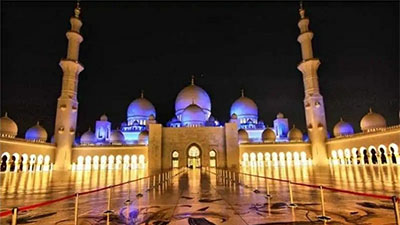 Thousand Lights Mosque is a multi-domed Mosque in Anna Salai in Chennai. It is one of the largest Mosques in the country and is a revered place of worship and azadari for Shia Muslims in the city.
Thousand Lights Mosque is a multi-domed Mosque in Anna Salai in Chennai. It is one of the largest Mosques in the country and is a revered place of worship and azadari for Shia Muslims in the city.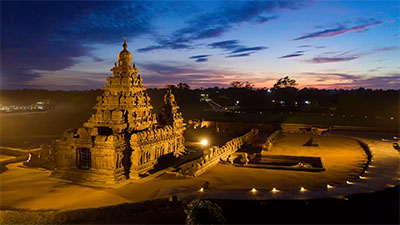 Shore Temple, Mahabalipuram (built in 700-728 AD) is so named because it overlooks the shore of the Bay of Bengal. It is a structural temple, built with blocks of granite, dating from the 8th century AD. At the time of its creation, the site was a busy port during the reign of Narasimhavarman II of the Pallava dynasty. As one of the Group of Monuments at Mahabalipuram, it has been classified as a UNESCO World Heritage Site since 1984. It is one of the oldest structural (versus rock-cut) stone temples of South India.
Shore Temple, Mahabalipuram (built in 700-728 AD) is so named because it overlooks the shore of the Bay of Bengal. It is a structural temple, built with blocks of granite, dating from the 8th century AD. At the time of its creation, the site was a busy port during the reign of Narasimhavarman II of the Pallava dynasty. As one of the Group of Monuments at Mahabalipuram, it has been classified as a UNESCO World Heritage Site since 1984. It is one of the oldest structural (versus rock-cut) stone temples of South India.
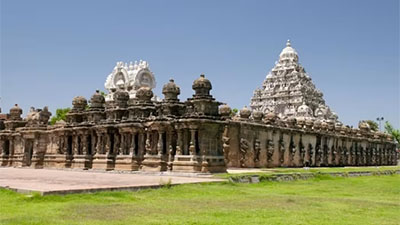 Kanchipuram also known as the City of Thousand Temples, is known for its temple architectures, 1000-pillared halls, huge temple towers and silk saris.
Kanchipuram also known as the City of Thousand Temples, is known for its temple architectures, 1000-pillared halls, huge temple towers and silk saris.
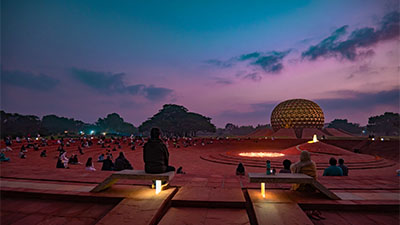 Auroville (City of Dawn French: Cité de l'aube) is an experimental township, mostly in the state of Tamil Nadu, India, with some parts in the Union Territory of Pondicherry in India.
Auroville (City of Dawn French: Cité de l'aube) is an experimental township, mostly in the state of Tamil Nadu, India, with some parts in the Union Territory of Pondicherry in India.
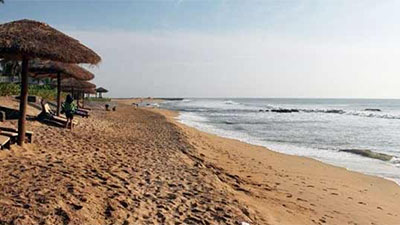 Covelong (Kovlam) Beach is located on the coast of the Bay of Bengal near a village named Covelong, 40 km from Chennai. Kovalam Beach is on the way to Mahabalipuram near the East Coast Road.
Covelong (Kovlam) Beach is located on the coast of the Bay of Bengal near a village named Covelong, 40 km from Chennai. Kovalam Beach is on the way to Mahabalipuram near the East Coast Road.